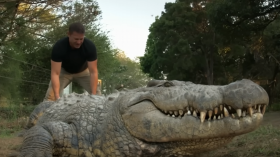A new study suggests that instead of killing pesky snails, gardeners can just throw them away from the garden.
According to researchers, snails have homing instinct and can navigate back to home patch. However, this instinct can be overcome by a strong arm.
Researchers at the Queen Mary University of London and the University of Exeter have found that throwing snails at a distance of 20 meters away from the garden prevents them from coming back. The method could help people who don't want to kill the slimy creatures, researchers said.
"We showed that the number of snails regularly or irregularly visiting a garden is many times greater than the number actually present at any one time in the garden," said Dr David Dunstan from Queen Mary University of London, who is the co-author of the study, said in a news release.
"As such, gardeners shouldn't be setting out to eliminate their gardens of snails. To achieve such a feat would require the gardener to rid the whole neighbourhood of snails, which would be a slow process," Dunstan added.
Dr Dunstan began the study in 2001. The team found a small garden that was being refurbished. Researchers caught the snails, marked them and threw them some 20 meters away on a wasteland. Snails that came back to the garden received another marking.
During the course of the study, 416 snails were marked and thrown over the wall of the garden.
Researchers then created a computer model that allowed them to analyze snails' behavior. They found that homing instinct of the snails was the only way of explaining the organism's behavior.
"A gut feeling or even a gut certainty that the data say something is not science. The data must be scientifically demonstrated and the only way we were able to do this was to give the snails a homing instinct," continued Dr Dunstan.
The research might sound silly, but demonstrates that gardeners can avoid damage to plants by simply removing the snails without using traps or chemicals - Suzy Lindstrom, Physica Scripta Editor, wrote in an article, Los Angeles Times reported.
The study is published in the journal Physica Scripta and can be read here.
© 2024 NatureWorldNews.com All rights reserved. Do not reproduce without permission.





